Introduction to Bisi Bele Bath
Bisi Bele Bath, a quintessential dish from the heart of Karnataka, represents a rich tapestry of flavors that embody the culinary heritage of this South Indian state. Traditionally, this hearty meal is a wholesome blend of rice, lentils, and a symphony of spices, delivering a nutritious and comforting dish ideal for any meal of the day. The dish’s unique name, which translates to “hot lentil rice dish” in Kannada, underscores its essence as a warm, spicy, and satisfying meal.
The cultural significance of Bisi Bele Bath in Karnataka extends beyond mere sustenance. It is a staple at festive occasions and family gatherings, symbolizing a fusion of flavors much like the diverse cultures of the region. In keeping with traditional recipes, the Pure and Sure brand commits to authenticity by sourcing local, organic ingredients, thus ensuring that each packet of Bisi Bele Bath masala brings you not only taste but also a connection to Indian culinary roots.
Embracing the old with the new, Pure and Sure endeavors to maintain the rich flavors of this beloved dish while making it accessible to modern kitchens across the globe. By adhering to traditional methods and recipes, they ensure that each serving of Bisi Bele Bath is as genuine as it is delicious.
Ingredients and Substitutes
Creating the perfect Bisi Bele Bath involves a harmony of rice, toor dal (split pigeon peas), and a meticulously crafted Bisi Bele Bath masala. Here’s a breakdown of the essential ingredients and some adaptable substitutes to cater to various dietary needs:
- Main Ingredients:
- Rice: Typically, short-grain Sona Masoori rice is used for its ability to absorb flavors. However, Basmati rice can be a fragrant substitute if preferred.
- Toor Dal: This particular type of lentil is crucial for the dish’s texture and protein content. An alternative could be moong dal, which is lighter and easier to digest.
- Bisi Bele Bath Masala: The soul of the dish, this spice mix can be homemade or store-bought. The masala usually contains a blend of dry roasted spices like coriander seeds, cumin, cinnamon, cloves, and cardamom.
- Optional Ingredients and Substitutes:
- Allergen-Free Alternatives: For a nut-free version, omit cashews or peanuts typically used in the tempering. Coconut oil can replace ghee for a vegan option, maintaining the rich flavor without dairy.
- Low-Sodium Adjustments: Reduce the salt and use low-sodium tamarind paste to cater to those monitoring their salt intake.
- Gluten-Free Needs: Ensure that the asafoetida (hing) used is gluten-free, as some brands may contain wheat flour.
Understanding the ingredients and how they contribute to Bisi Bele Bath’s delightful flavor and texture ensures that you can customize the dish to suit dietary preferences without compromising on taste.
Step-by-Step Recipe
Mastering the art of Bisi Bele Bath involves several key steps: preparing the rice and lentils, cooking the vegetables, mixing and simmering the ingredients, and the final flourish of tempering. Here’s how to bring all these elements together for a perfect dish:
Preparation of Rice and Lentils
- Rinsing: Start by thoroughly rinsing the rice and toor dal under cold water until the water runs clear. This removes excess starch and improves the texture of the dish.
- Cooking: Combine the rinsed rice and dal in a pressure cooker with water and a pinch of turmeric. Cook under pressure for about 3 whistles or until both are soft and mushy. Let the pressure release naturally.
Cooking Vegetables
- Selection: Choose a variety of fresh vegetables like carrots, peas, and bell peppers for a colorful and nutritious mix.
- Preparation: Chop all vegetables into uniform pieces to ensure even cooking.
- Cooking: In a separate pan, heat a little oil and sauté the vegetables with a pinch of salt until they are just tender. Keep them vibrant and crunchy as they will cook further when mixed with rice and dal.
Mixing and Simmering the Ingredients
- Combining: Add the sautéed vegetables to the cooked rice and dal mixture. Stir in the Bisi Bele Bath masala, ensuring it’s evenly distributed.
- Simmering: Add enough water to achieve a semi-liquid consistency, similar to a thick stew. Allow the mixture to simmer gently, stirring occasionally to prevent sticking and to ensure flavors meld beautifully.
- Seasoning: Adjust salt and add tamarind juice for a tangy flavor balance.
Final Preparation with Tempering
- Tempering Ingredients: Heat ghee in a small pan. Add mustard seeds and wait till they splutter. Then, add curry leaves, hing, and dried red chilies.
- Finishing Touch: Pour the hot tempering over the Bisi Bele Bath. This not only adds a layer of flavor but also an aromatic finish that is visually appealing.
- Garnishing: Garnish with chopped coriander leaves and a sprinkle of grated coconut or fried cashews for an added texture.
Each step in the preparation of Bisi Bele Bath is crucial, contributing to its complex flavor and comforting texture. By following these detailed steps, you ensure a delightful culinary experience that celebrates the traditional essence of this beloved South Indian dish.
Variations of the Recipe
Bisi Bele Bath is a versatile dish that welcomes various adaptations, making it suitable for different dietary preferences and available ingredients. Here are some creative twists to personalize this classic recipe:
- Different Vegetable Additions:
- Traditional vegetables in Bisi Bele Bath include carrots, peas, and eggplant. However, you can enhance the dish by incorporating bell peppers or zucchini for added color and texture.
- Roasted or sautéed beforehand, these vegetables can offer a subtle sweetness or a slight bite, enriching the overall flavor profile of the dish.
- Use of Alternative Proteins:
- For a protein-rich, vegetarian version, consider adding chickpeas or tofu. These ingredients not only boost the protein content but also add a delightful texture contrast.
- Chickpeas should be cooked until tender before adding, while tofu can be lightly fried or added as is, depending on personal preference.
These variations allow individuals to tailor the dish to their taste and dietary needs while maintaining the soul-warming essence of traditional Bisi Bele Bath. Experimenting with different ingredients can transform this dish into a new yet familiar delight each time it’s prepared.
Nutritional Information
Bisi Bele Bath, a well-loved South Indian dish, is not just a feast for the senses but also offers a range of nutritional benefits:
- Caloric Content: A single serving of Bisi Bele Bath can vary in calories, generally around 300-400 calories, depending on the use of ghee or oil and the proportion of rice and lentils.
- Health Benefits of Key Ingredients:
- Rice and Toor Dal: These provide a good source of energy through carbohydrates and are rich in protein, essential for muscle repair and growth.
- Vegetables: Adding a variety of vegetables increases the dish’s fiber, vitamin, and mineral content, supporting overall health and digestion.
- Spices like Turmeric and Asafoetida: Known for their anti-inflammatory and digestive properties, these spices not only enhance flavor but also contribute to the dish’s health benefits.
By combining complex carbohydrates, proteins, and vital nutrients from vegetables and spices, Bisi Bele Bath is a balanced meal option.
Expert Tips and Common Mistakes
Creating the perfect Bisi Bele Bath involves understanding the nuances that contribute to its unique flavor and texture. Here are some expert tips and common pitfalls to help you master this dish:
Best Practices for Perfect Consistency and Flavor
- Consistent Heat: Maintain a medium-low heat during the simmering process to allow flavors to meld without burning the bottom of the pan.
- Balanced Spices: Use freshly ground Bisi Bele Bath masala for the best flavor. The freshness of the spices dramatically enhances the overall taste of the dish.
- Proper Proportions: Ensure a balanced ratio of rice to lentils to water. Typically, a 1:1 ratio of rice to lentils with about four times water provides a perfect consistency.
Common Pitfalls and How to Avoid Them
- Overcooking Vegetables: To maintain the nutritional content and texture of the vegetables, add them at the correct time so they do not become too mushy. Semi-cook them before adding to the rice and dal mixture.
- Clumping of Masala: To prevent the spices from clumping and ensure they are evenly distributed throughout the dish, mix the Bisi Bele Bath masala with a small amount of water to create a paste before adding it to the pot.
- Skipping the Tempering: The tempering (tadka) is crucial for adding depth to the dish. Do not skip this step, and be sure to use ingredients like mustard seeds, curry leaves, and asafoetida to elevate the dish’s flavor profile.
By adhering to these practices and avoiding common errors, you can prepare a Bisi Bele Bath that is both delicious and visually appealing.
Serving and Pairing Suggestions
Bisi Bele Bath is a flavorful, hearty dish that pairs wonderfully with a variety of accompaniments to enhance its taste and texture:
- Raita: A cooling yogurt-based condiment with cucumber or boondi, raita complements the warmth of Bisi Bele Bath, balancing its rich and spicy flavor.
- Papad: Crispy papads add a delightful crunch, serving as a perfect contrast to the soft, mushy texture of the rice and lentils.
- Pickle: A small serving of spicy Indian pickle can elevate the meal with its tangy and hot flavors, providing a burst of taste with every bite.
These accompaniments not only add variety to the meal but also enhance the overall dining experience by introducing different textures and flavors.
FAQs
Frequently asked questions about Bisi Bele Bath help clarify the best practices and essential ingredients for making this traditional dish:
- What is the best type of rice to use for Bisi Bele Bath?
- The ideal rice for Bisi Bele Bath is short-grained Sona Masoori, known for its ability to absorb flavors well. Basmati rice can be used as a substitute for a different texture and aroma.
- What are the key spices in Bisi Bele Bath masala?
- Essential spices in the Bisi Bele Bath masala include coriander seeds, cumin seeds, black peppercorns, dried chilies, fenugreek seeds, cinnamon, cloves, and cardamom. These spices are typically dry roasted and ground into a fine powder.
- Can Bisi Bele Bath be made in a vegan version?
- Absolutely! Replace ghee with coconut oil and ensure that no other animal-derived ingredients are used. Coconut oil provides a rich flavor that complements the spices well.
- How should leftovers be stored?
- Leftover Bisi Bele Bath can be stored in an airtight container in the refrigerator for up to 3 days. Reheat gently, adding a little water if the mixture has thickened.
Conclusion
Bisi Bele Bath is not just a meal; it’s a delightful experience that brings together the rich flavors and traditions of Karnataka cuisine. By following the detailed steps and considering the variations, this dish can be tailored to meet a variety of dietary preferences, making it a versatile option for any meal.
- Embrace Local Flavors: Using local and fresh ingredients not only enhances the flavor but also supports sustainable cooking practices.
- Experiment and Enjoy: Don’t hesitate to experiment with different proteins or vegetables to keep the dish exciting and new.
- Health and Flavor: With its wholesome ingredients and rich spices, Bisi Bele Bath is a perfect blend of health and taste, proving that traditional dishes can be both nutritious and delicious.
Whether you are new to Indian cuisine or a seasoned chef, Bisi Bele Bath offers a window into the culinary heritage of South India.

